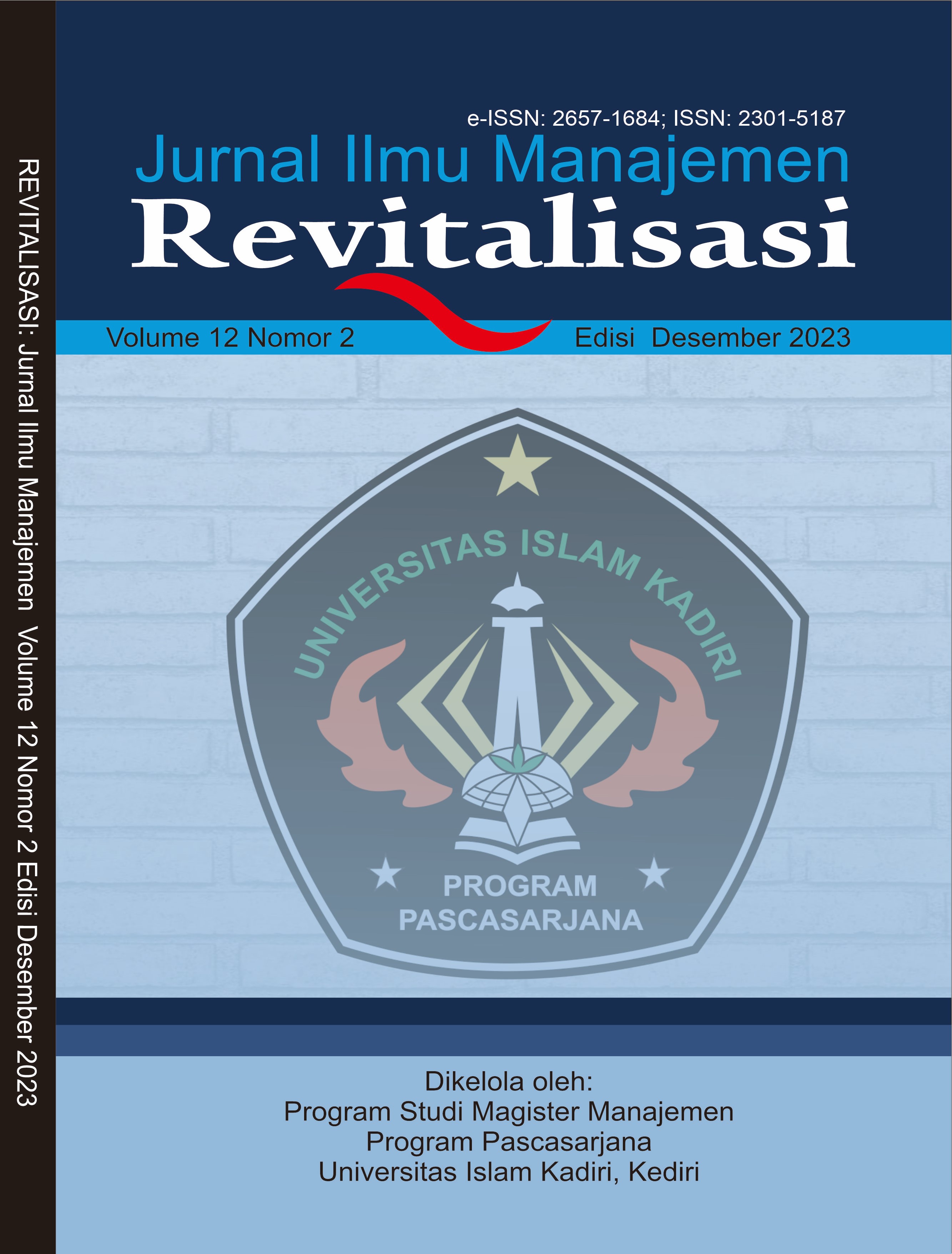Inovasi Hijau, Umur Top Management, dan Profitabilitas: Studi pada Perusahaan Listrik
Abstract
The matter of climate change is progressively emerging as a worldwide preoccupation. Companies must innovate in order to overcome this challenge and simultaneously sustain their profitability. The future trajectory of a company is heavily contingent upon the extent to which its leaders actively pursue and implement innovative practices. This study seeks to examine the correlation between green innovation, the age of senior management, and profitability in electricitiy companies, which are the primary contributors to carbon emissions. Utilizing panel data regression analysis with secondary data spanning from 2013 to 2022, this study reveals that green process innovation exerts a noteworthy influence on return on assets (ROA). Furthermore, the age of top management acts as a moderating factor in the association between green process innovation and ROA. However, green product innovation does not exert a substantial influence on profitability. This study addresses the lack of research conducted on electricity comapnies, providing valuable insights for corporate stakeholders who are contemplating investments in green innovation and taking age into account when choosing top management. To enhance the academic rigor of this study, other factors pertaining to top management characteristics, such as educational background and diversity of the top management team, can be used.
References
Ar, Ilker Murat. “The Impact of Green Product Innovation on Firm Performance and Competitive Capability : The Moderating Role of Managerial Environmental Concern.†Procedia - Social and Behavioral Sciences 62 (2012): 854–864. http://dx.doi.org/10.1016/j.sbspro.2012.09.144.
Belenzon, Sharon, Anastasiya Shamshur, and Rebecca Zarutskie. “CEO’s Age and The Performance of Closely Held Firms.†Strategic Management Journal 40, no. 6 (June 1, 2019): 917–944.
Chen, Yu-shan, Shyh-bao Lai, and Chao-tung Wen. “The Influence of Green Innovation Performance on Corporate Advantage in Taiwan.†Journal of Business Ethics 67 (2006): 331–339.
Cogan, Douglas G. “Corporate Governance and Climate Change.†Criminological and Legal Consequences of Climate Change, no. March (2014).
Daellenbach, Urs S., Anne M. McCarthy, and Timothy S. Schoenecker. “Commitment to Innovation: The Impact of Top Management Team Characteristics.†R and D Management 29, no. 3 (1999): 199–208.
Dangelico, Rosa Maria, and Devashish Pujari. “Mainstreaming Green Product Innovation: Why and How Companies Integrate Environmental Sustainability.†Journal of Business Ethics 95, no. 3 (2010): 471–486.
Du, Kerui, Pengzhen Li, and Zheming Yan. “Do Green Technology Innovations Contribute to Carbon Dioxide Emission Reduction? Empirical Evidence from Patent Data.†Technological Forecasting and Social Change 146, no. April 2018 (2019): 297–303. https://doi.org/10.1016/j.techfore.2019.06.010.
Duque-Grisales, Eduardo, Javier Aguilera-Caracuel, Jaime Guerrero-Villegas, and Encarnación GarcÃa-Sánchez. “Does Green Innovation Affect The Financial Performance of Multilatinas? The Moderating Role of ISO 14001 and R&D Investment.†Business Strategy and the Environment 29, no. 8 (December 1, 2020): 3286–3302.
Ghardallou, Wafa. “Corporate Sustainability and Firm Performance: The Moderating Role of CEO Education and Tenure.†Sustainability (Switzerland) 14, no. 6 (2022).
González-Benito, Javier, and Óscar González-Benito. “Operations Management Practices Linked to the Adoption of ISO 14001: An Empirical Analysis of Spanish Manufacturers.†International Journal of Production Economics 113, no. 1 (2008): 60–73.
Gujarati, Damodar N., and Dawn C. Porter. Basic Econometrics. The McGraw-Hill, 2009.
Hair, Joseph F., William C. Black, Barry J. Babin, and Rolph E. Anderson. Multivariate Data Analysis. Vol. 7. Pearson, 2014.
Hambrick, Donald C., and Phyllis A. Mason. “Upper Echelons: The Organization as a Reflection of Its Top Managers.†Academy of Management Review 9, no. 2 (1984): 193–206.
Hart, Stuart L. “A Natural-Resource-Based View of The Firm.†Academy of Management Review 20 (1995): 986–1014.
He, Xiaoping, and Shuo Jiang. “Does Gender Diversity Matter for Green Innovation?†Business Strategy and the Environment 28, no. 7 (2019): 1341–1356.
Lee, Ki-hoon, and Byung Min. “Green R & D for Eco-Innovation and Its Impact on Carbon Emissions and Fi Rm Performance.†Journal of Cleaner Production (2015). http://dx.doi.org/10.1016/j.jclepro.2015.05.114.
Oware, Kofi Mintah, and Dadson Awunyo-Vitor. “CEO Characteristics and Environmental Disclosure of Listed Firms in an Emerging Economy: Does Sustainability Reporting Format Matter?†Business Strategy and Development 4, no. 4 (December 1, 2021): 399–410.
Peni, Emilia. “CEO and Chairperson Characteristics and Firm Performance.†Springer Science+Business Media, LLC, no. June (2012).
Rayfield, Blake, and Omer Unsal. “Green Innovation and Environmental Misconduct.†Managerial Finance 48, no. 8 (2022): 1156–1173.
Rescigno, Elizabeth T. “Relationship Between Chief Executive Officer Compensation, Duality, and Return on Equity.†Walden University, 2018.
Ross, Stephen A., Randolph W. Westerfield, Jeffrey Jaffe, and Bradford D. Jordan. Corporate Finance. Corporate Finance, 2017.
Ross, Stephen A., Randolph W. Westerfield, and Bradford D. Jordan. Fundamentals of Corporate Finance. McGraw Hill, 2022.
Rothaermel, and Frank. Strategic Management, 2021.
Solomon, M. Real People, Real Choices. Pearson, 2013.
Tang, Mingfeng, Grace Walsh, Daniel Lerner, Markus A. Fitza, and Qiaohua Li. “Green Innovation, Managerial Concern and Firm Performance: An Empirical Study.†Business Strategy and the Environment 27, no. 1 (2018): 39–51.
Tanikawa, Tomohiko, and Yuhee Jung. “Top Management Team (TMT) Tenure Diversity and Firm Performance: Examining The Moderating Effect of TMT Average Age.†International Journal of Organizational Analysis 24, no. 3 (July 11, 2016): 454–470.
Tariq, Adeel, Yuosre Badir, and Supasith Chonglerttham. “Green Innovation and Performance: Moderation Analyses from Thailand.†European Journal of Innovation Management 22, no. 3 (2019): 446–467.
Vincent, L Barker III, and C Mueller George. “CEO Characteristics and Firm R&D Spending.†Management Science 48, no. 6 (2002): 782. http://proquest.umi.com/pqdweb?did=135292861&Fmt=7&clientId=4574&RQT=309&VName=PQD%5Cnpapers3://publication/uuid/9045D93C-3B72-447C-8A8C-A2241CDBFC39.
Wiersema, Margarethe F, and Karen A Bantel. “Top Management Team Demography and Corporate Strategic Change.†Academy of Management Journal 35, no. 1 (1992): 91–121.
Xie, Xuemei, Jiage Huo, and Hailiang Zou. “Green Process Innovation , Green Product Innovation , and Corporate Financial Performance : A Content Analysis Method ☆.†Journal of Business Research 101, no. January (2019): 697–706. https://doi.org/10.1016/j.jbusres.2019.01.010.

This work is licensed under a Creative Commons Attribution 4.0 International License.
 This work is licensed under a Creative Commons Attribution 4.0 International License
This work is licensed under a Creative Commons Attribution 4.0 International License




















